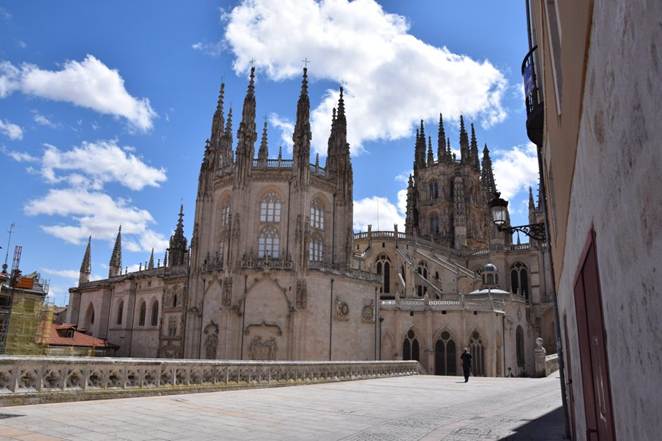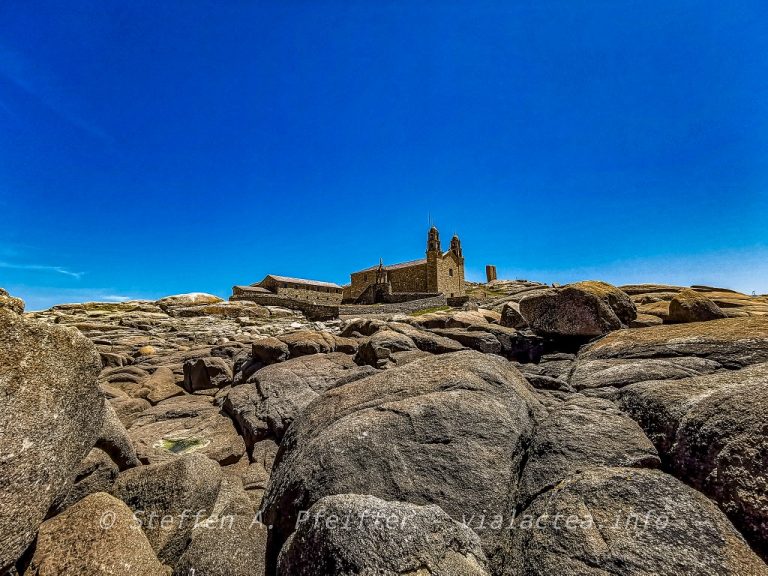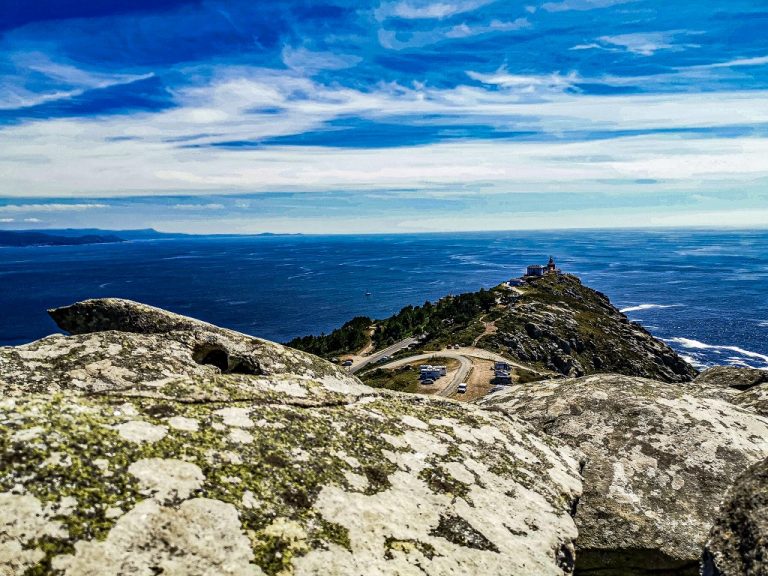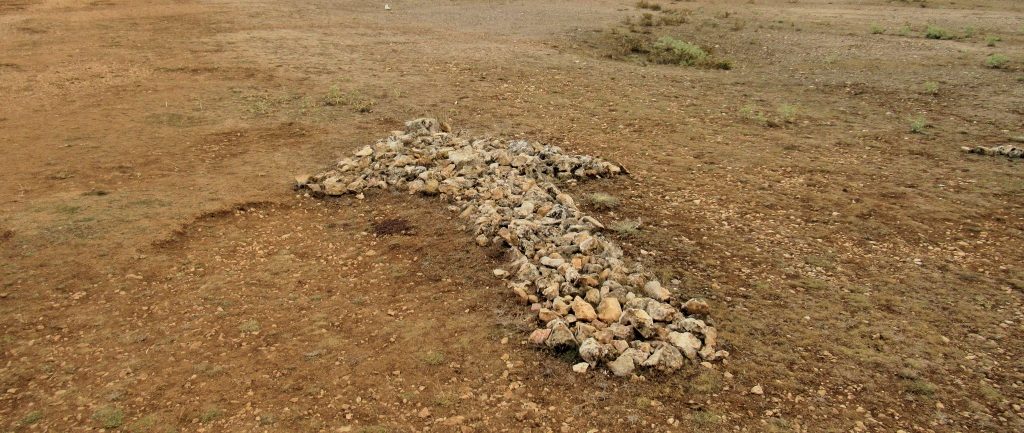
A New Stage Day – Beginning & Atmosphere
The morning breaks gently over the monastery of San Juan de Ortega. Mist hangs over the Montes de Oca, and the silence of the Romanesque walls accompanies you for one last stretch. The night in the monastery feels like a rite of passage – and now you are drawn onward, out into the plain of Castile, toward Burgos. Today the solitude of the forests ends and the immersion begins into a world where human history, art, and culture are at home.
Route & Elevation Profile
- Distance: approx. 26.6 km, about 6 hours walking time
- Elevation profile: After a small climb to the “Cruz de Madera” follows a gentle descent into the wide plain. Technically easy, but a long stage.
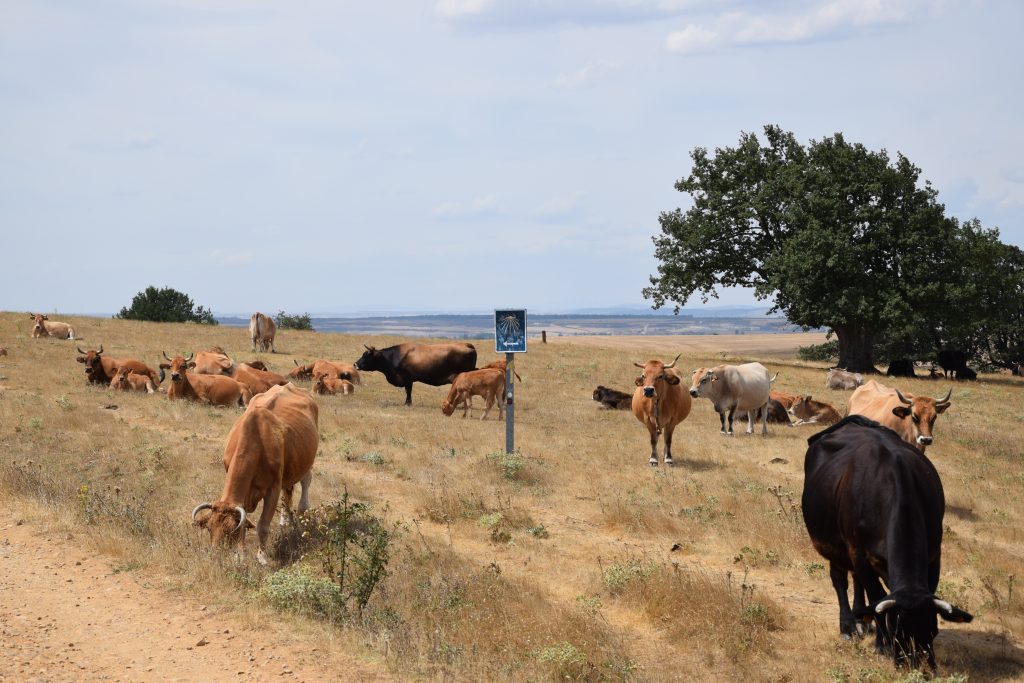
Variants & Small Detours
The official path leads from San Juan de Ortega to Agés and further to Atapuerca. It is worth pausing there for a moment – for this place is one of the most significant of European prehistory.
At the city entrance to Burgos there are variants: either through the industrial suburb of Gamonal, or more pleasantly along the Río Arlanzón through greener zones – a gentler, though somewhat longer alternative.
Description of the Way – With All Senses
You leave San Juan de Ortega and climb gently up to the “Cruz de Madera,” where a simple wooden cross stands in the wind. From here the landscape opens: Castile lies before you, wide and flat, the sky large and clear.
Soon you reach Agés, a small village whose houses are built of golden-colored stone. The church of San Eulalia greets you from the center, and the brook gives the place a quiet, rural atmosphere. Many pilgrims rest here briefly – a coffee, a piece of bread, and the way carries you on.
Only a few kilometers later you arrive in Atapuerca. Here, where today lies an inconspicuous village, is one of the most important archaeological sites in Europe. In the nearby caves were discovered remains of the so-called “Atapuerca Man” – 1.2 million years old and testimony to the earliest settlement of Europe. These finds are part of the UNESCO World Heritage. Whoever lifts their gaze sees the menhirs standing on the hills – stone witnesses of ancient cultures. A place that deeply connects the pilgrim’s path with human history.
A side reference for you: In Burgos awaits the Museo de la Evolución Humana, where the original finds from Atapuerca are impressively presented – a perfect conclusion to this stage, to span the arc from prehistory to the cathedral.
The Camino leads further through fields and along gravel paths to Cardeñuela Riopico and Orbaneja, quiet places offering little more than a few houses and a bar. Here you taste the simple life of Castile: vegetables from the own garden, bread fresh from the oven.
Then you reach Villafría, the suburb of Burgos. Here begins the city entrance – for many pilgrims a rather tedious section. The high-rises of Gamonal appear unwelcoming, and the streets are busy with traffic. Yet whoever chooses the detour through Castañares and along the Río Arlanzón experiences a greener, more pleasant way.
Step by step Burgos rises before you. Finally you stand before the Puerta de Santa María, the splendid city gate that leads you into the heart of the old town. And there, at the end of the way, rises the Cathedral of Burgos – a masterpiece of Gothic architecture, built over several centuries. The site itself had previously been a mosque in the Mozarabic style, later becoming a symbol of Christian Castile. Today the cathedral is UNESCO World Heritage and one of the most impressive churches in Spain. When you step onto the square in front of it, the towers overwhelm you, rising like stone fingers into the sky.
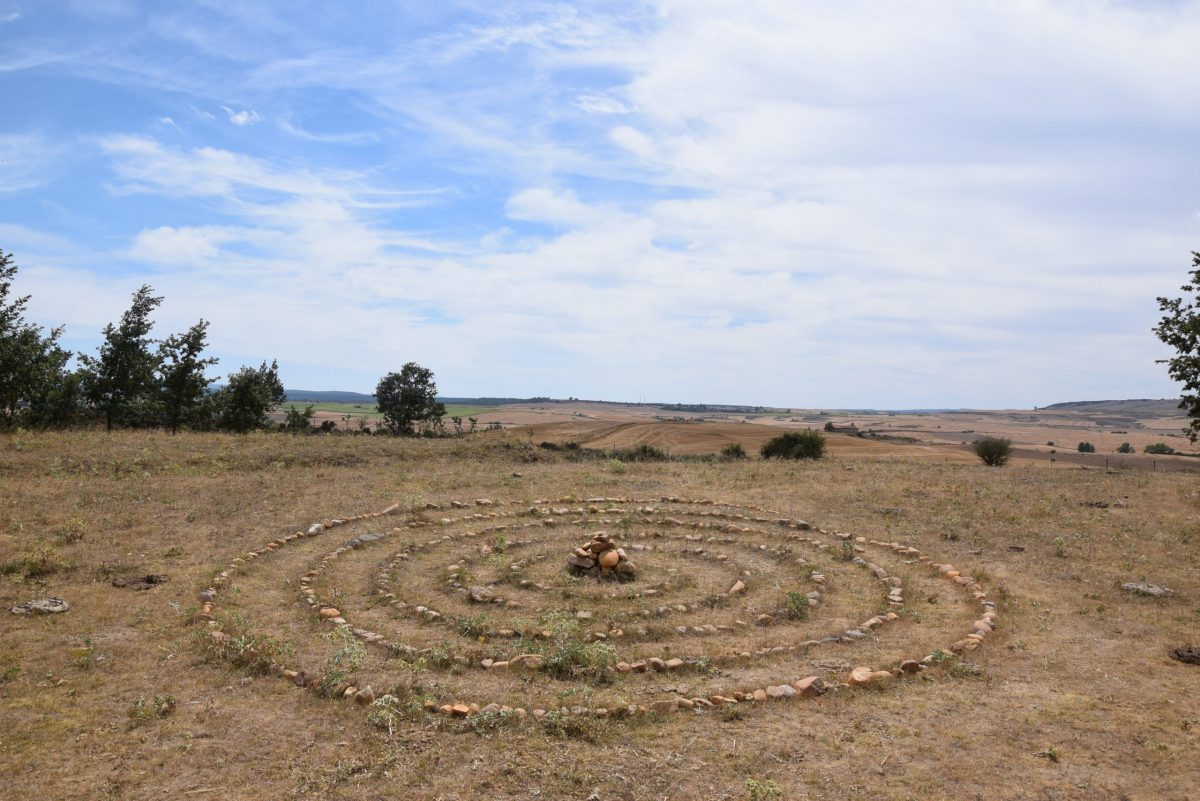
Intermediate Villages & Special Features
| Village | Distance from start | Special Feature | Tip |
| Agés | ca. 4 km | Church San Eulalia, quiet village | Take your first rest |
| Atapuerca | ca. 7 km | Site of Atapuerca Man, UNESCO World Heritage | Side reference: visit museum in Burgos |
| Cardeñuela / Orbaneja | ca. 12 km | Small villages, bars, rural atmosphere | Short pause possible |
| Villafría | ca. 16 km | Suburb of Burgos, beginning of city area | Detour along river path |
| Burgos | ca. 26.6 km | Cathedral, Puerta de Santa María, Human Evolution Museum | Stage goal & city experience |
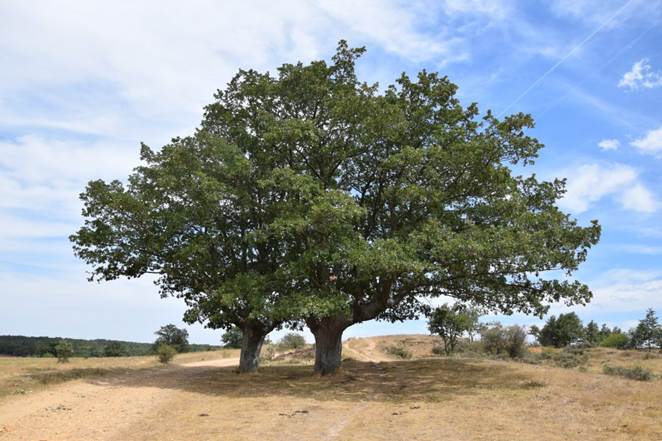
Packing & Shopping Tips
- Supply: Bars in Agés, Atapuerca, Cardeñuela and Orbaneja. Afterwards longer stretches until Burgos.
- Tip: In Atapuerca a snack is worthwhile – you stand here amidst prehistory.
- Bring: Light shoes for the city area, and perhaps a small sweet as motivation for the last asphalt kilometers.
Food, Lodging & Supply
- San Juan de Ortega: Monastery hostel, El Descanso, La Cuadra de Luisito – all about €15
- Agés: Taberna, Fagus (hostels about €15)
- Atapuerca: El Peregrino, Plazuela Verde (hostels €15–20)
- Burgos: Albergue Casa del Cubo (€10), La Divina Pastora (€11), hostels e.g. Catedral (€23–25)
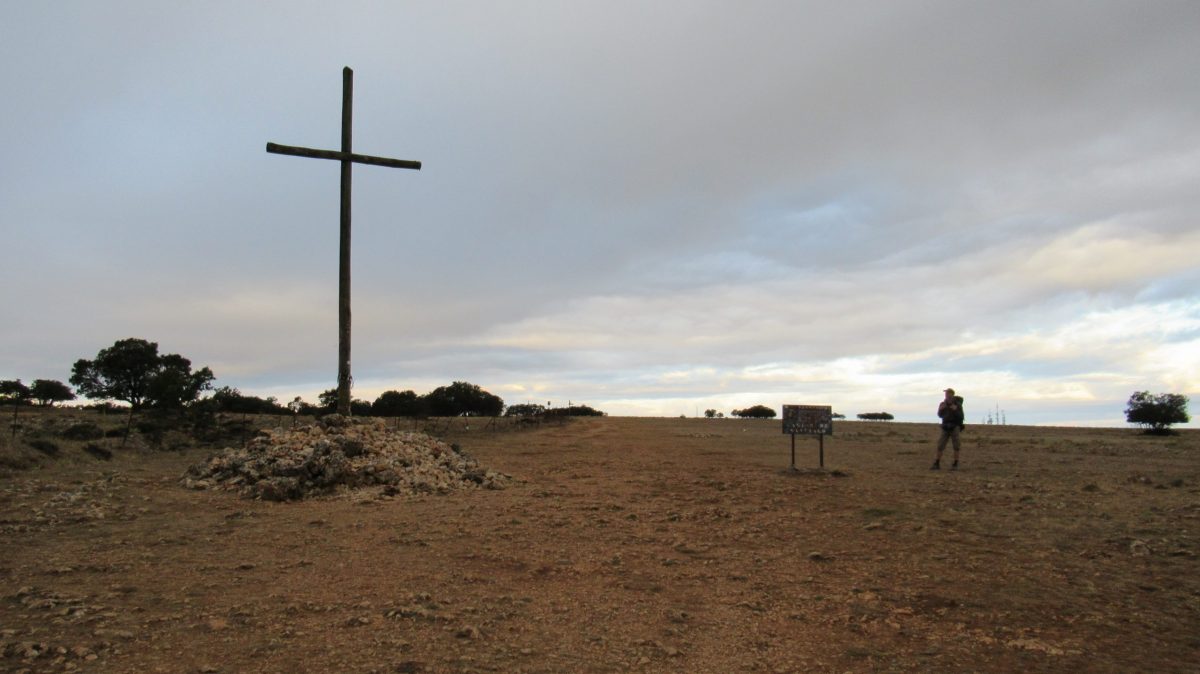
The Special Feature Today
The stage leads you from the mystical silence of the monastery of San Juan de Ortega into the depths of human history at Atapuerca – and from there further into the living present of a city that unites history, culture, and cuisine.
Culinary Highlight – Morcilla de Burgos
When you arrive in Burgos in the evening, be sure to treat yourself to the Morcilla de Burgos. This blood sausage with rice, onions and spices is a culinary specialty of the city. Hot and crispy fried, served with bread and red wine, it is not only a meal but a piece of Castilian identity. A perfect conclusion after a long pilgrim’s day.
Reflection at the End of the Stage
When you stand in the evening light before the cathedral, the towers rising into the sky and the square full of voices and footsteps, you may ask yourself: “Which moves me more – the millions of years of Atapuerca Man or the centuries of the Cathedral of Burgos? And what place do I myself find in this great history?”
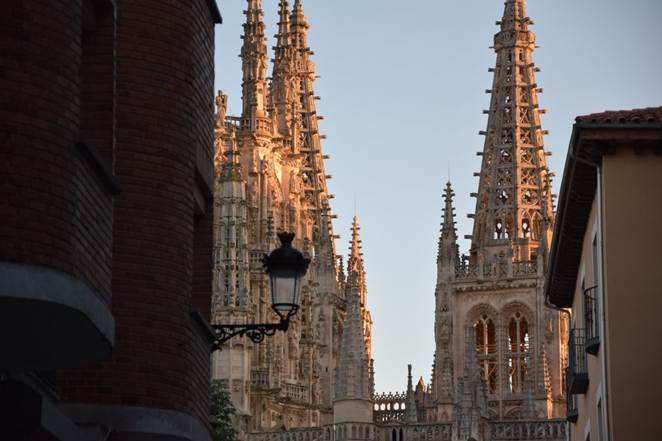
📊 Tabular Overview
| Stage | Start | Goal | Distance | Elevation gain/loss | Difficulty | Intermediate villages |
| 12 | San Juan de Ortega | Burgos | ca. 26.6 km | small ascent / mostly descent | medium | Agés, Atapuerca, Cardeñuela, Villafría, Burgos |
🌌 Camino of the Stars
San Juan de Ortega → Agés → Atapuerca → Cardeñuela Riopico → Villafría → Burgos
Have you already been to the Museo de la Evolución Humana in Burgos or tasted the Morcilla? Share your impressions – they are part of the living history of the Camino.
